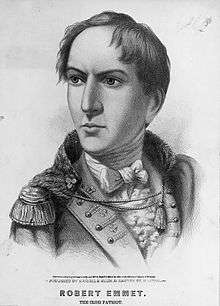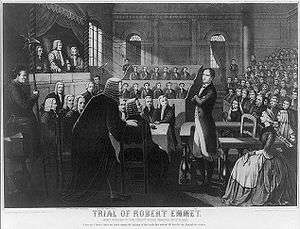Irish Rebellion of 1803
| Irish Rebellion of 1803 | |||||||
|---|---|---|---|---|---|---|---|
| |||||||
| Belligerents | |||||||
|
|
| ||||||
| Commanders and leaders | |||||||
|
|
| ||||||
| Casualties and losses | |||||||
| ~50 killed, 17 executed | ~20 killed | ||||||
The Irish Rebellion of 1803 was an unsuccessful attempt by a group of Irish nationalists to secure Ireland's independence from the United Kingdom.
Leaders

Robert Emmet (4 March 1778 – 20 September 1803) was the leader of the Irish Rebellion of 1803. Son of a doctor, he grew up in relatively comfortable circumstances. As a child, he was influenced by his revolutionary older brother Thomas Addis Emmet and his brother's friend Theobald Wolfe Tone. He started at Trinity College, Dublin in October 1793 at the age of fifteen and there became involved in the College Historical Society as an Irish nationalist. He eventually joined and became secretary of the college's United Irish Society, an Irish republican organization that launched the Irish Rebellion of 1798. In the aftermath of that rebellion, a warrant was issued for his arrest and he fled to the continent. He there attempted to secure military aid from revolutionary France for a second rebellion. Unsuccessful, he returned to Ireland in October 1802.
Thomas Russell (21 November 1767 – 21 October 1803), born in Dromahane, County Cork to an Anglican family, he joined the British army in 1783 and served in India. He returned to Ireland in 1786 and commenced studies in science, philosophy and politics. in July 1790 he met Theobald Wolfe Tone in the visitor's gallery in the Irish House of Commons and they became firm friends. In 1796, Russell published an ambitious and far-sighted document, Letter to the People of Ireland, which laid out his vision of social and economic reform for the Irish nation. In addition to his stance on religious freedom, he had made clear his anti-slavery views, in the Northern Star on 17 March 1792 whose editorial comment took a less generous view by agreeing with Russell, but pointing out the immediate necessity to liberate three million slaves in Ireland.
James Hope (25 August 1764 – 1847) was a United Irishmen leader who fought in the 1798 and 1803 rebellions against British rule in Ireland. He was born in Templepatrick, County Antrim to a Presbyterian family originally of Covenanter stock. He was apprenticed as a linen weaver, but attended night school in his spare time. James Hope was influenced by the American Revolution and the French Revolution. He joined the Irish Volunteers and, upon the demise of that organization, the Society of the United Irishmen in 1795. Upon the outbreak of the 1798 rebellion in Leinster Hope was sent on a failed mission to Belfast. When the general uprising had collapsed James Hope was able to elude capture and refused to avail of the terms of an amnesty offered by Lord Cornwallis on the grounds that to do so would be "not only a recantation of one's principles, but a tacit acquiescence in the justice of the punishment which had been inflicted on thousands of my unfortunate associates". He is today regarded as the most egalitarian and socialist of all the United Irish leadership.
Preparations
In 1802 they began to manufacture weapons and explosives at a number of premises in Dublin and even innovated a folding pike which could be concealed under a cloak, being fitted with a hinge. Unlike in 1798, the preparations for the uprising were successfully concealed, but a premature explosion at one of Emmet's arms depots killed a man and forced Emmet to bring forward the date of the rising before the authorities' suspicions were aroused.
Emmet was not able at all to secure the help of Michael Dwyer's Wicklow rebels, and many Kildare rebels who had arrived turned back due to the scarcity of firearms they had been promised. Additionally, because of the various setbacks and weather conditions, there was purportedly confusion over what date the rebellion was taking place. Nevertheless, the rising went ahead in Dublin on the evening of 23 July 1803.
23 July 1803
The plan was to seize a few strategic positions within the city of Dublin and then wait for others to rebel. Their main target was Dublin Castle which was reported to be lightly guarded but was a highly symbolic target as the seat of British government in Ireland since the lordship of King John. The main combat of the rebellion took place on Thomas Street where a major riot broke out. There, Robert Emmet witnessed a British dragoon be pulled from his horse and executed. Upon seeing the brutality of those who had risen up, Emmet called off the rebellion, but he had command of only the original contingent of men who rebelled. At one point, the rebels on Thomas Street saw the Lord Chief Justice of Ireland, Lord Kilwarden, reviled as chief prosecutor of William Orr in 1797, but also the judge who granted habeas corpus to Wolfe Tone in 1798. He was dragged from his carriage and hacked to death. Sporadic clashes continued into the night until finally quelled by the military at the estimated cost of 20 military and 50 rebel dead.
Aftermath

Emmet fled into hiding but was captured on 25 August, near Harold's Cross. He endangered his life by moving his hiding place from Rathfarnam to Harold's Cross so that he could be near his sweetheart, Sarah Curran. He was tried for treason on 19 September; the Crown repaired the weaknesses in its case by secretly buying the assistance of Emmet's defence attorney, Leonard McNally, for £200 and a pension. However his assistant Peter Burrowes could not be bought and pleaded the case as best he could.
After he had been sentenced Emmet delivered a speech, the Speech from the Dock, which is especially remembered for its closing sentences and secured his posthumous fame among executed Irish republicans. However no definitive version was written down by Emmet himself.
Let no man write my epitaph; for as no man who knows my motives dare now vindicate them, let not prejudice or ignorance, asperse them. Let them and me rest in obscurity and peace, and my tomb remain uninscribed, and my memory in oblivion, until other times and other men can do justice to my character. When my country takes her place among the nations of the earth, then and not till then, let my epitaph be written. I have done.
On 20 September, Emmet was executed in Thomas Street. He was hanged and then beheaded once dead.[1]
Russell managed to hide for a number of weeks but Dublin was a bad place to hide in the days following the failure of Emmet's rebellion as the shocked authorities had launched a massive campaign of raids and arrests in an effort to finally eradicate the United Irishmen. He was promptly arrested and sent to Downpatrick Gaol where he was executed by hanging then beheaded on 21 October 1803.
Fifteen tradesmen and labourers, who were also hanged for their participation, are commemorated on a plaque at St. Catherine's church off Thomas Street.[2]
References
- ↑ "Irish Historical Mysteries: The Grave of Robert Emmet". Homepage.tinet.ie. 20 September 2003. Retrieved 7 July 2012.
- ↑ "Tradesmen who took part in the 1803 Rising". Robertemmet.org. Retrieved 7 July 2012.
External links
- Peter Linebaugh, 21 October 2003; Is This the Place? -On the Bicentennial of the Hanging of Thomas Russell
- Full text of Emmett's Speech from the Dock